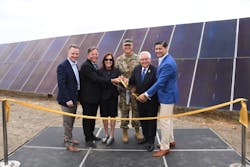California National Guard Commissions Solar Microgrid at Joint Forces Base Los Alamitos
The California National Guard’s Joint Forces Training Base (JFTB) in Los Alamitos serves as an emergency response hub for Southern California, providing critical support during events such as wildfires and earthquakes.
Now the base’s efforts during federal and state emergencies will be reinforced by a new solar powered microgrid.
A ribbon cutting ceremony was held last week to celebrate the launch of the microgrid, which first broke ground in May 2022. The microgrid, located on a 100-acre parcel of land leased from the U.S. Army, includes 31 MW of solar, 40 MWh of battery energy storage and 3 MW of tier 4 backup generators.
Earlier this month, Microgrid Knowledge reported that Ameresco acquired the Los Alamitos microgrid project from the project’s developer, Arizona-based Bright Canyon Energy; it is expected that Ameresco will also acquire Bright Canyon Energy later this year.
One microgrid, two customers
Located in Orange County, Los Alamitos JFTB is home to the California National Guard’s (CalGuard) 40th Infantry Division, the Los Alamitos Army Airfield and the U.S. Air Force Auxiliary Civil Air Patrol’s 150th Air Search and Rescue. It is also the site of Sunburst Youth Academy, one of two CalGuard live-in military-style educational programs for at-risk teens.
Power generated by the microgrid will be sold to San Diego Gas and Electric during times of normal operation to meet the energy needs of the community surrounding the base. During outages, however, the microgrid will seamlessly disconnect from the grid so that all generated electricity can be devoted to supporting the base’s operations.
“This is the first of its kind,” said Rachel Jacobson, assistant secretary of the Army Installations, Energy and Environment, U.S. Department of the Army. “We have other microgrids that supply [critical load] power to particular areas of bases … but this is the first one that will supply power for a minimum of 14 days for the entire base,” she said.
Combating climate change and ensuring national security
“This project is a prime example of the whole government approach that makes good on the Department of Defense’s climate adaptation plan, the Army’s climate strategy and makes good on Gov. [Gavin] Newsom’s climate adaptation strategy,” said Maj. Gen. Matthew P. Beevers, the adjutant general of the California Military Department.
MGK wants you! Military Microgrids will be key issues discussed at Microgrid 2024 in Baltimore
Our Call for Speakers is now open: Submit your session ideas
The Los Alamitos microgrid is another in a growing list of microgrid installations on U.S. military bases, including Marine Corps Air Station Miramar, White Sands Missile Range and Kirtland Air Force Base. The Army has plans to install a microgrid at each of its bases by 2035 and the Navy and Marine Corps have made similar commitments.
“Climate change is a national security threat,” added Jacobson. “To increase the resilience of our bases, and thereby the capabilities of our forces, we must reduce our use of fossil fuels.”
Track military microgrid projects. Subscribe to the free Microgrid Knowledge Newsletter.








